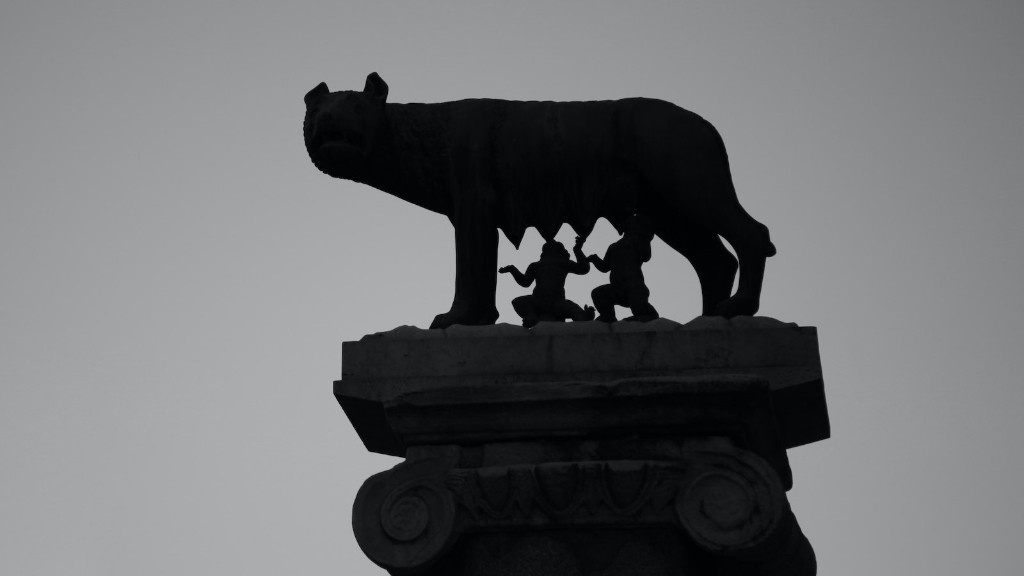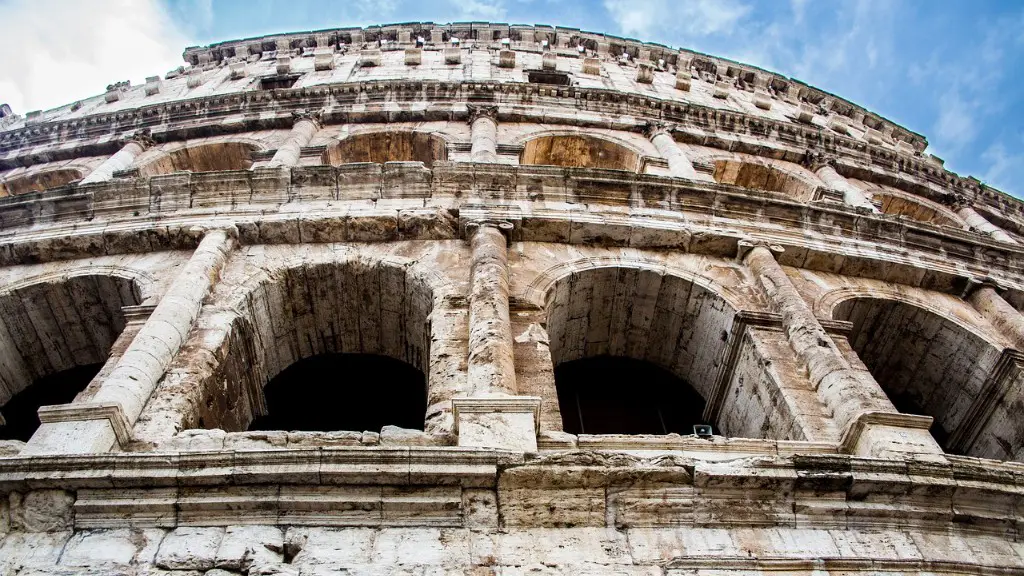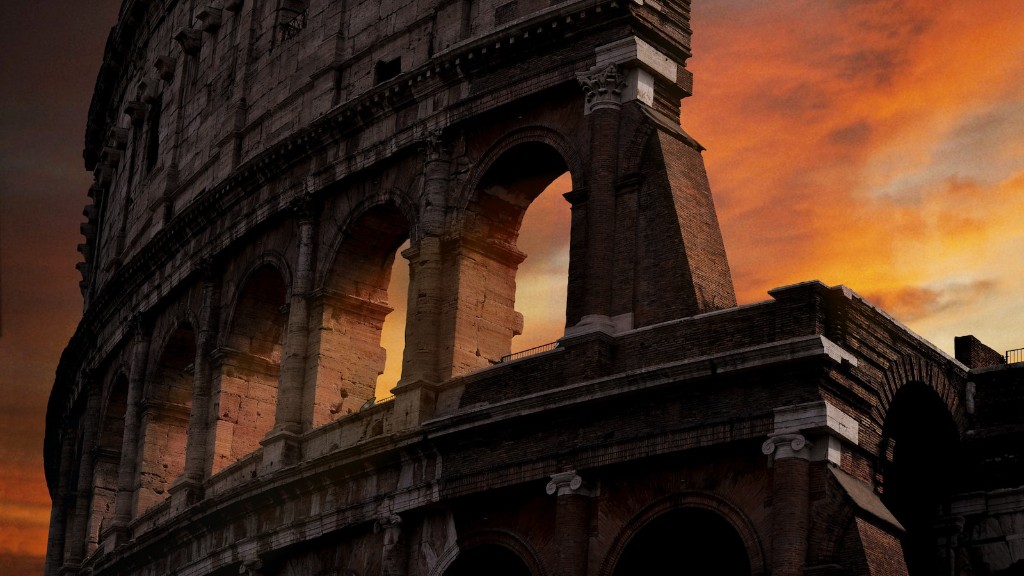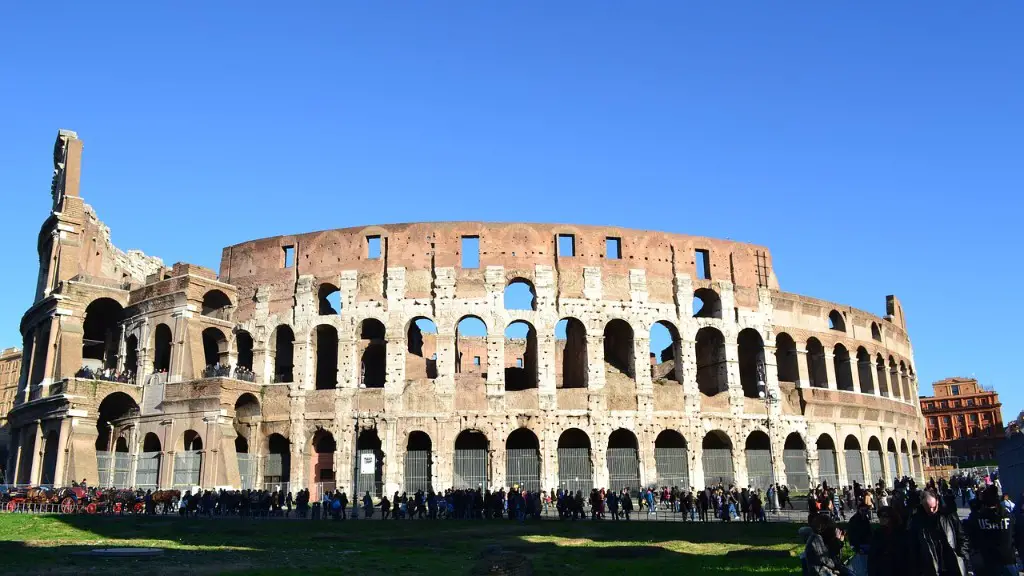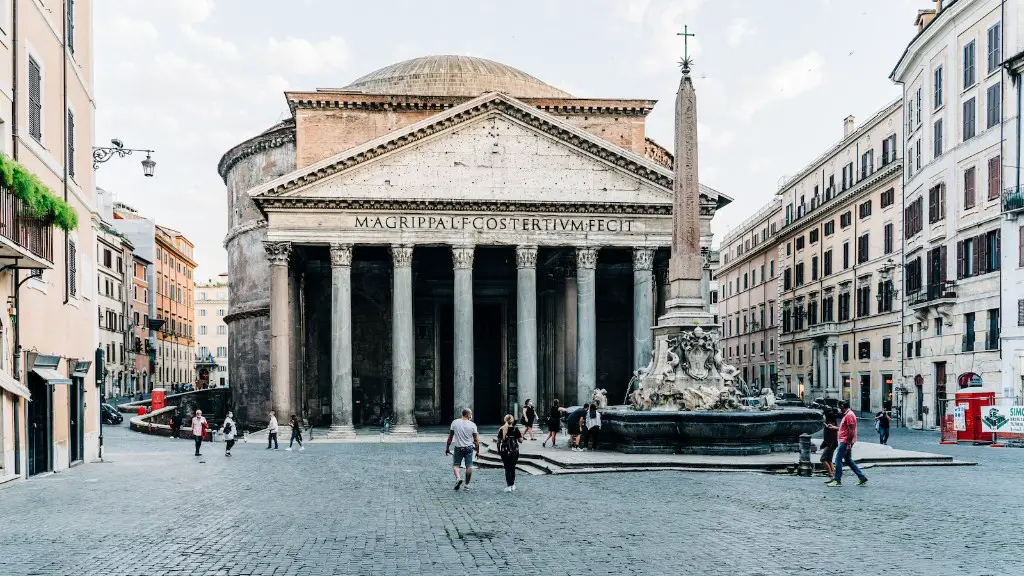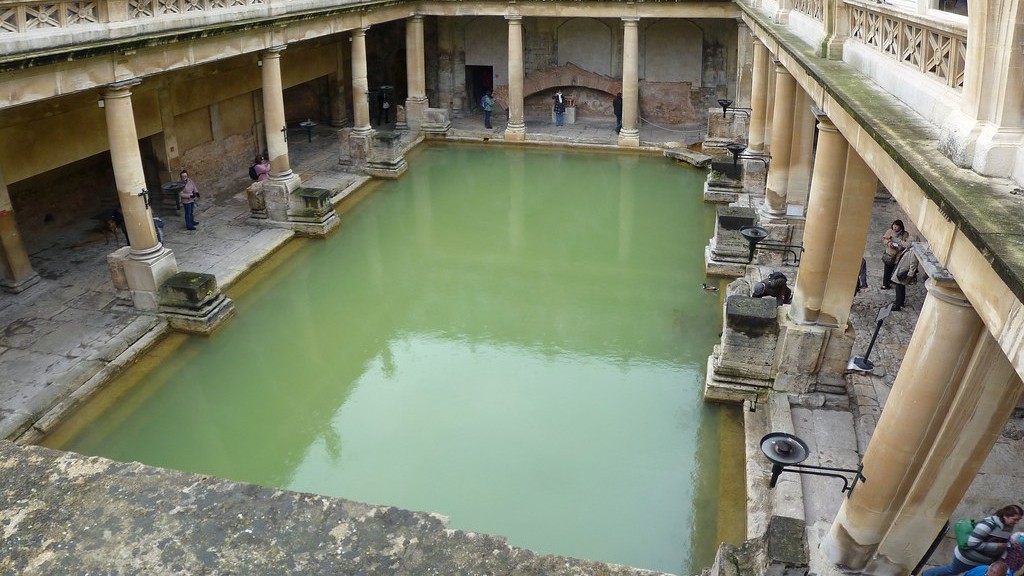The Colosseum
The Colosseum was the largest public stadium in Ancient Rome, capable of seating up to 50,000 spectators. Built in 70-80AD, it was once the grandest arena for public entertainment in the city, hosting a wide range of events from gladiator matches to mock sea battles. The Colosseum was built on the site of Nero’s infamous ‘Golden House’, whose remains can still be seen today. In its heyday, the Colosseum was a symbol of power and prestige, both for the Roman Empire and its people.
The Colosseum is made up of four main levels of seating, each arranged around a central oval space where the events were held. The uppermost level was reserved for the Emperor and his family, while the higher-ranking members of society were seated in the tiers below. The lowest tier, located closest to the action, was usually occupied by the lower classes.
The powerful engineering of the Colosseum enabled it to cope with the demands of its thousands of spectators with ease. Its arched entrances and arches allowed for rapid entry and exit, and it even included a state-of-the-art drainage system so the arena could be kept dry even in the rain. Its vast seating was supported by a sturdy wooden substructure, and the entire structure was reinforced with strong cages filled with sand and crushed stone to protect it from earthquakes.
In its final years, the Colosseum was used for a variety of non-violent shows. It also served as a place for public executions. Despite this, it was still a popular destination for tourists of all classes and was barely damaged by the fires that swept across Rome in 455AD.
Today, the Colosseum is one of the most-visited tourist attractions in the world. It continues to inspire awe amongst the millions of visitors who travel from all corners of the globe to witness its grandeur firsthand. For many, the Colosseum stands as a symbol of Ancient Rome’s strength and resilience.
Stadium of Domitian
The largest public stadium in Rome prior to the Colosseum was the Stadium of Domitian. Built around 85AD by the Emperor Domitian, this enormous stadium could fit up to 250,000 spectators at its peak. It was used primarily for chariot races, and also served as a venue for boxing and gladiator contests.
The Stadium of Domitian was located in the middle of the Campus Martius, side-by-side to the Temple of Isis. While the Colosseum is oval in shape, the Stadium was elliptical with a central track that was surrounded by tiers of seating. The upper seats were reserved for senators and other dignitaries, with the general public occupying the lower tiers.
In terms of engineering, the Stadium of Domitian was astonishingly advanced. Its arches, which are still standing today, were 26 metres wide and held up enormous amounts of weight. Its seating was also made of durable concrete and was able to accommodate around 100,000 spectators comfortably.
The Stadium of Domitian was in use until the early 5th century, when it fell into disuse due to the decline of the Roman Empire. It was subsequently destroyed, and today its ruins are what remains of this once immense stadium.
Circus Maximus
Another large public stadium in Ancient Rome was the Circus Maximus. Built in the 6th century BC, it was the oldest of the three stadiums and was used primarily for horse races. It could seat up to 250,000 people, making it the second largest stadium in Rome after the Stadium of Domitian.
The Circus Maximus was situated in the centre of Rome, just to the east of the Palatine Hill. It was built in a U-shape and was approximately 800 metres long and 150 metres wide. Its seating was divided into three sections – one for the senators, one for the general public, and one for foreign ambassadors and VIPs. At either end of the U-shape was a spina, a raised platform where the chariots and horses started the race.
The Circus Maximus was a hugely popular attraction, and races were held for over 1,000 years before it was eventually abandoned. Its ruins can still be seen today, and it is now a popular site for visitors to the city.
Stadium of Pompey
The smallest of the three stadiums in Ancient Rome was the Stadium of Pompey. Built in 55BC, it was commissioned by Julius Caesar’s son-in-law, Marcus Porcius Cato and was used primarily for political rallies, debates and theatrical performances. It could seat up to 20,000 people, making it the smallest of the three stadiums.
The Stadium of Pompey was located close to the Forum Romanum and featured a raised rectangular platform at one end where the speakers and performers stood. Its seating was divided into seven tiers, with the senators occupying the top tier, followed by the knights, the equestrians, the public, and the foreigners on the lower tiers. At the rear of the stadium was a garden where the spectators could relax after the shows.
The Stadium of Pompey was where Julius Caesar was fatally stabbed in 44BC. It was destroyed in the Great Fire of Rome in 64AD and its remains are now buried beneath the modern-day Torre Argentina.
Conclusion
The Colosseum, the Stadium of Domitian, the Circus Maximus and the Stadium of Pompey were the four largest public stadiums in Ancient Rome. Together, they provided an impressive backdrop to the grand entertainments of the Roman Empire. These amazing architectural feats are still standing today, and continue to fascinate visitors from across the world.
Architectural Design
The design of the four stadiums in Ancient Rome was stunning. Whether it was the elliptical shape of the Stadium of Domitian, the oval Colosseum or the sprawling Circus Maximus, the stadiums were built with impressive engineering techniques. Their stonework, wooden substructures and arches, meant that these stadiums could withstand the thousands of visitors that flocked to them for entertainment.
In addition to their grandiose architecture, the stadiums were strategically located in the middle of the cities, making them easily accessible to the public. This was no doubt intentional on the part of the Romans, as it helped to amplify their political power and advanced engineering skills.
The Romans were indeed masters of engineering and construction, and the four stadiums of Ancient Rome are testaments to their skills. They are still standing today, thousands of years later, and continue to amaze visitors from all over the world.
Impact Of Stadiums On Roman Culture
The stadiums of Ancient Rome played a major role in the culture of the Roman Empire. They provided the Romans with a sense of magnificence and grandeur, as well as a place to enjoy various forms of public entertainment. Because of their immense size, the stadiums also helped to unite the population in a common goal or cause.
The stadiums served as platforms for the Roman people to show their loyalty to the state and their faith in the empire. The Colosseum, in particular, was the most impressive of the four stadiums and is often thought of as a symbol of Rome’s might and power. It was the venue for some of the most famous shows and gladiator fights, and was even visited by the emperors themselves.
The stadiums of Ancient Rome also provided the Roman citizens with a sense of pride and identity. They were a testament to the wealth and glory of the empire, and a reminder of the power and sophistication it possessed. They were also important sites of spectacle and celebration, and a place where people could come together to show their loyalty and enthusiasm for the empire.
Effect Of Stadiums On Modern Culture
The impressive architecture of the stadiums in Ancient Rome continues to influence modern day architecture to this day. The Colosseum is perhaps the most iconic of the four stadiums, and its design has since been copied in various forms throughout the world. Its elliptical floor plan and sturdy arches have been incorporated into many sporting arenas and other public spaces.
The stadiums of Ancient Rome are also an inspiration to contemporary sports fans, who continue to be fascinated by the events that were held there. Visitors to the Colosseum marvel at its grandeur and the sheer number of people that it could hold. It continues to be seen as a symbol of Rome’s power and strength, and stands as a reminder of the spectacular events that it hosted in its heyday.
The stadiums of Ancient Rome remain an integral part of the city’s culture and heritage, and will continue to captivate visitors for generations to come. They are a reminder of the ingenuity and engineering skills of the Roman Empire and a testament to their legacy.
